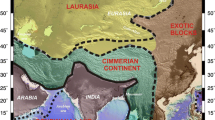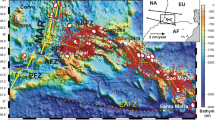Abstract
For first time, during 1991, seismic activity was recorded during an eruption at Colima volcano. We analyze these data to obtain a stress pattern using a composite focal mechanism technique. From the analysis of regional seismicity, the Tamazula Fault and the Armeria River appear as active features and the dip of the slab east of the Jalisco Block is approximately 12°. Southwest of Colima volcano a vertical alignment of seismic events was observed. We estimate five different composite focal mechanism solutions from our data set, which indicate a change of the stress field at the volcano after the 1991 eruption. These solutions suggest that the stress field in the volcanic edifice was controlled by stresses related to the emplacement of magma superimposed on the regional stress field. No evidence of active local faults in the volcanic edifice was found. We propose a model for the eruptive process that involves tilting of the volcanic edifice.
Similar content being viewed by others
Author information
Authors and Affiliations
Additional information
Received: 15 October 1995 / Accepted: 26 October 1998
Rights and permissions
About this article
Cite this article
Núñez-Cornú, F., Sánchez-Mora, C. Stress Field Estimations for Colima Volcano, Mexico, Based on Seismic Data. Bull Volcanol 60, 568–580 (1999). https://doi.org/10.1007/s004450050252
Issue Date:
DOI: https://doi.org/10.1007/s004450050252




